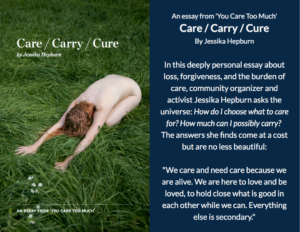I get it. People are shy to have their work edited by others. There’s a deep-seated deer-in-headlights moment when we know that our work is going to be looked at by someone else; someone who might have a critique for us! It sends us directly back to grade school and red pens and “writing lines” exactly perfectly, row by row.
However, sometimes an informed second opinion can help. And sometimes, we simply need to take a second look.
Check out the following snippet of a blog post from Jemma at Squidge & Bean, etc. Guess which sample is the unedited first draft, and which is after a few questions to the author.
Sample A
Last night, R. got out of bed. “I’m going to school tomorrow,” she shouted from the top of the stairs. Then, she got back into bed and slept until morning. Sometimes the excitement of childhood makes me want to weep happy tears.
Sample B
Rachel is a sleeping superstar; each night we read a book together as she snuggles with her doggie, we blow each other kisses as I close the door, and then she sleeps for eleven hours. Last night was different. Ten minutes after the final kiss goodnight, her door opened and my husband and I listened to her pitter-patter footsteps from the living room below. “I’m going to school tomorrow,” she sang out from the safety-gate at the top of the stairs. Without giving us the chance to go up to her, she skipped back to bed and slept until morning. Sometimes the uncontrollable excitement of childhood makes me want to weep happy tears.
Differences
Can you see how, in the second sample, the author shows us an image? (Hint: Sample B isn’t the first draft.) By rounding out some details, we get a clearer picture of the scene, and even begin to see that the main character here is a little girl–possibly on the eve of her first day of school. We start to feel the excitement from the writing, long before the word “excitement ever appears.
In working with Jemma, I asked questions to dig a little deeper into the content. I asked her about emotions and details, and we talked about bringing the reader right into the details by crafting a scene with her writing.
how can I do some of this myself?
1. When writing your first draft, write. Get it all out! Then, run through your writing again and ask yourself, “How can I show instead of tell”?
2. Read your writing out loud. Like, with a full voice and a pretend audience. You can do this with your bio, your sales pages, blog posts: anything. Where something doesn’t sound right to your ear, it probably isn’t working right on the paper. Mark it and go back to figure it out.
3. Your high school english teacher was right: if at all possible, do your writing and let it sit overnight. When you pick it up again the next day, you’ll likely see the typos and awkward word associations and tense problems.
things to watch for
1. Typos on your etsy listings–people can’t find your product if it isn’t captured in the search term.
2. Confused chronology in instructions–something so simple as listing your shipping before your ordering information can throw a buyer off. Not only is it confusing, but it sets up an idea that your biz isn’t super-professional.
3. Appropriate language and tone–chatty convos can be quite inviting. . . if that fits the nature of your business. If you are working on high end orders, you might think about slightly more formal language.
when do I really need an editor?
Professional editors can help with all of the above, but also with a grander vision of your work’s direction. Substantive editing can involve completely re-organizing the content and structure of your writing to make it flow or be more persuasive. Copy editing can help your sentences flow and be more easily readable. Editors watch for potential mis-communications and flag possible legal points. And more.
Now, I encourage you to be brave! Think about your writing as a two-step process: build in time to take a second look at it. Enlist a brilliant friend to help out. Or, if your business warrants it, consider hiring a professional.
And tell me, have you ever written and had someone else look at your work? How did it turn out for you? What did it feel like?
Special thanks go out to Jemma at at Squidge & Bean, etc. for her bravery at having all of us look at her writing (before & after!) and her cooperation with tackling my suggestions!


